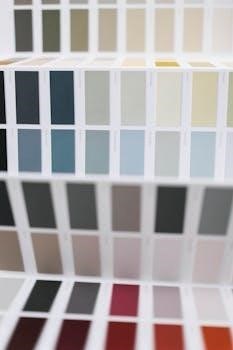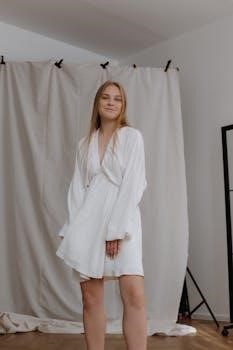Gingival Shade Guides⁚ An Overview
Gingival shade guides are essential tools in dentistry for achieving natural-looking restorations. These guides help dentists and technicians accurately determine the correct gingival shade for prostheses‚ ensuring an optimal match with the patient’s soft tissue.
Purpose of Gingival Shade Guides
The primary purpose of gingival shade guides is to facilitate the selection of appropriate gingival colors for dental prosthetics‚ such as full-arch implant prostheses and dentures. Without a suitable shade guide that offers a sufficient range of gingival colors‚ creating aesthetically pleasing prosthetics becomes challenging. These guides help ensure that the artificial gingiva closely matches the patient’s natural soft tissue‚ leading to more realistic and harmonious results. They are particularly useful when fixed restorations require tissue-shaded flanges or cervical areas‚ improving the overall appearance of the restoration.

Types of Gingival Shade Guides
Various gingival shade guides are available to assist dental professionals. These guides differ in their composition‚ the range of shades offered‚ and their compatibility with specific prosthetic systems.
BruxZir Gingival Shade Guide
The BruxZir Gingival Shade Guide is specifically designed for determining the correct gingival shade for BruxZir Full-Arch Implant Prostheses. It includes six shade tabs that precisely match the six available shades for the prosthesis. This ensures an optimal match with the patient’s soft tissue‚ resulting in aesthetically pleasing prosthetics. Using BruxZir polishing and finishing accessories allows for easy adjustments‚ polishing‚ and removal of BruxZir restorations‚ making it a comprehensive solution for gingival shade matching in implant dentistry.
Ivoclar Gingiva Shade Guide (IPS Gingiva Shade Guide)
The Ivoclar Gingiva Shade Guide‚ also known as the IPS Gingiva Shade Guide‚ helps achieve high-end‚ natural-looking restorations. This shade guide is particularly useful when a fixed restoration requires a tissue-shaded flange or cervical area‚ or when addressing the gingival embrasure between splinted units. The IPS Gingiva shade guide system offers 10 shades‚ including five regular shades‚ four gingival modifier shades‚ and one gingival opaquer shade‚ providing a comprehensive range for custom shade matching.
VITA Classical Shade Guide (Relevance to Gingival Shades)
The VITA classical A1-D4 shade guide is primarily used to accurately determine tooth shade‚ with the shades arranged by reddish-brownish (A)‚ reddish-yellowish (B)‚ greyish (C)‚ and reddish-grey (D) hues. While the VITA classical shade guide is mainly for teeth‚ specialized shade guides exist for selecting the correct gingival shade for implant prostheses. These gingival shade guides often feature a limited number of shades‚ precisely matched to the available shades of the specific implant prosthesis system‚ ensuring optimal aesthetic outcomes.
Denture Gum Shade Guides
Denture gum shade guides are color guides used for choosing the appropriate gum color for denture base acrylics. Typically‚ there are four standard colors to choose from‚ allowing for a custom mix or blend of gingival shades if needed. Systems like the Gradia gum shades system are designed based on extensive analysis of natural gingiva shades. These guides offer practical assistance for everyday shade selection‚ proposing combinations of Gum opaque and Body materials to achieve realistic results in denture fabrication‚ contributing to a more natural-looking prosthetic.

Shade Matching Process
The shade matching process involves careful selection of the appropriate shade using a gingival shade guide. This ensures that the prosthetic closely resembles the natural tissue‚ achieving optimal aesthetics.
Importance of Facial Alignment
Facial alignment plays a crucial role in accurate shade matching. Keeping the shade guide tab in the same facial alignment as the tissue being matched is essential. Correct alignment minimizes shadows and ensures that the color is viewed under consistent lighting conditions. This reduces the risk of selecting an incorrect shade due to visual distortions caused by improper positioning. When the shade guide is aligned correctly‚ the dentist can make a more precise assessment of the tissue’s true color‚ leading to better aesthetic outcomes.
Factors Affecting Shade Selection
Several factors influence the accuracy of gingival shade selection‚ including lighting conditions‚ the observer’s visual acuity‚ and the presence of any external elements that might distort the perception of color.
Lip Overlap and Shadows
Lip overlap and shadows significantly impact gingival shade selection. When the lip overlaps the gingival area‚ it can create shadows that distort the perceived color. It’s crucial to ensure the lip isn’t casting a shadow on the gingiva during shade matching. Proper facial alignment and retraction techniques should be employed to minimize these effects. Accurate shade selection requires a clear‚ unobstructed view of the gingival tissues. Shadows can lead to incorrect shade choices‚ resulting in restorations that do not blend seamlessly with the surrounding tissues. Therefore‚ careful attention to lighting and lip position is essential.

Materials Used in Gingival Shade Guides
Gingival shade guides utilize materials that accurately represent gingival colors. IPS e.max Ceram is one material used. The shade tabs are fired from original materials‚ ensuring the desired outcome.
IPS e.max Ceram
IPS e.max Ceram is a material used in creating gingival shade guides‚ integral to the product concept for shade matching. The shade tabs are carefully crafted from original IPS d.SIGN materials under controlled laboratory conditions. This ensures they accurately represent the desired aesthetic result. The material shade guides are designed to assist dental professionals in achieving predictable and lifelike gingival restorations‚ with consideration given to light refraction and surface texture‚ enhancing the overall shade-matching process‚ making it a reliable choice for dental aesthetics.
Custom Shade Matching
Custom shade matching involves techniques like mixing ceramic colors to create individualized gingival shades. This ensures a precise match with the patient’s natural tissue‚ leading to highly aesthetic results.
Mixing Ceramic Colors
Mixing basic ceramic colors is a practical approach for producing a range of pink shades‚ suitable for use as a physical gingival shade guide. The color spectrum can be based on ICE Ceramics Tissue shades‚ from light to dark‚ to reproduce an individualized and natural-looking gingiva. This method enables the creation of custom shades tailored to specific patient needs‚ ensuring a highly aesthetic and lifelike restoration that seamlessly blends with the surrounding tissues. By carefully blending different ceramic pigments‚ dental professionals can achieve unparalleled shade accuracy.
Beautifil II Gingival Shades
Beautifil II offers five gingival shades—dark pink‚ light pink‚ violet‚ brown‚ and orange—which can be blended to custom shade-match any soft-tissue topography. Using appropriate instruments and an adhesive technique‚ these shades allow for the creation of highly realistic and personalized gingival restorations. The versatility of Beautifil II gingival shades ensures a seamless integration with the surrounding tissues‚ resulting in an aesthetically pleasing outcome for patients requiring specialized gingival shade matching. The range of colors allows for subtle nuances to be replicated.

Coverage Error in Gingival Shade Guides
Coverage error (CE) is a critical factor in evaluating the effectiveness of gingival shade guides. It refers to the discrepancy between the shade selected using the guide and the actual shade of the patient’s gingiva. A lower coverage error indicates a more accurate and reliable shade guide. Studies aim to determine and compare the coverage errors of different gingival shade guides‚ or combinations‚ to identify the most effective tools for visual shade matching. Minimizing coverage error is essential for achieving aesthetically pleasing prosthetic outcomes.
Other Gingival Shade Guides
Besides the prominent guides‚ several other gingival shade guides exist. These include TCS Shade Guides‚ Lucitone 199 Shade Guide‚ and IvoBase Shade Guide‚ each offering unique features for shade matching.
TCS Shade Guides
TCS shade guides serve as a valuable reference tool in dental practices. They are specifically designed to assist dental professionals in accurately matching a patient’s natural gingiva color to the available shades of TCS (thermoplastic crystalline structure) resin. These guides play a crucial role in creating aesthetically pleasing and natural-looking dental prosthetics‚ ensuring a seamless blend with the surrounding tissues. Proper utilization of TCS shade guides contributes significantly to patient satisfaction and overall treatment success by achieving lifelike gingival aesthetics.
Lucitone 199 Shade Guide
The Lucitone 199 Shade Guide is a tool used in dental prosthetics‚ specifically for selecting the appropriate shade of acrylic resin for dentures. This guide typically consists of a set of shade tabs that represent the various shades available in the Lucitone 199 acrylic system. Dental professionals use this guide to match the denture base to the patient’s natural gingival tissue‚ ensuring a more aesthetic and natural-looking final result. The Lucitone 199 shade guide is essential for achieving patient satisfaction with their dentures.
IvoBase Shade Guide
The IvoBase Shade Guide is a component used in dental prosthetics‚ specifically with the IvoBase injection system for denture base materials. This guide aids dental professionals in selecting the correct shade for the denture base‚ ensuring a natural and aesthetically pleasing appearance. The IvoBase system utilizes a variety of shades to match the patient’s gingival tissue. By using the IvoBase Shade Guide‚ technicians can create dentures that blend seamlessly with the patient’s natural oral environment‚ enhancing the overall aesthetics and patient satisfaction.
